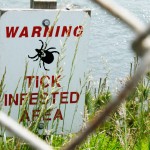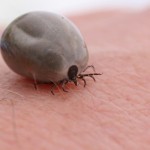In April of 2012 I wrote a series of posts on tick-borne diseases. This is my 315th post so when the subject of chronic Lyme disease (called post-treatment Lyme Disease syndrome {PTLDS} by the CDC) came up in a well-balanced article in The New Yorker I needed to revisit what I had written 14+ months ago before I could determine if there was anything new on the subject.
It delineates the ongoing controversy which basically comes down to whether chronic Lyme disease actually occurs. Most academic physicians and organizations deny that this exists, but a large group of patents with a multitude of long-term symptoms have interacted with physicians who are willing to treat such an entity. They've formed an International Lyme and Associated Diseases Society who "argue that the traditional approach to diagnosis and treatment, put forth by most American physicians, all but guarantees failure."
A pamphlet from a group formed to fund-raise and increase awareness, the Lyme Action Network, is titled "It Might Be Lyme." The multitude of symptoms under this rubric is astounding as is the conclusion that years of (often intravenous and horrendously expensive) antibiotic therapy is needed to ensure a cure of the ailment.
The author of the New Yorker article was recently interviewed by Terry Gross on NPR. He comments that our current state of knowledge of the illness is incomplete, but notes that the symptoms of many of those who are said to have "chronic Lyme" are vague, commonplace and difficult to attribute to this disease when there are no positive tests and/or they don't live in region of the country known to have Lyme disease.
Let's start with a comment. I found only one medical article that shifted my point of view even a tad bit.
A research group headed by a Johns Hopkins-associated physician with infectious disease training published a study of patients with PTLDS symptoms in a journal I've never heard of before: Quality of Life Research.
His group enrolled 63 patients with the skin manifestation of Lyme disease and systemic symptoms (therefore people with pretty clear-cut diagnoses to fit the ailment) in a prospective cohort study. They followed this group and the control subjects for six months and saw each of them five times. After conventional treatment with a three week course of the antibiotic doxycycline all signs of Lyme disease went away, but after six months slightly over a third of the patents had new-onset fatigue, one fifth had widespread pain and 45% had neurocognitive problems (thinking issues that relate to a particular part of the brain).
This is the first article I've seen that prospectively followed patients with Lyme disease, but my caveats are: it was a small group (63 patients) with obvious Lyme disease and the followup period is relatively short.
I'd like to see a considerably longer prospective study of a much larger group.
The introduction to the article mentions that Lyme disease is caused by a spirochete bacteria (therefore a long, coiled member of the same family as the syphilis, but there hasn't been human to human spread that I'm aware of and of course, Lyme is not a venereal disease). It is the most common vector-borne (transmitted by a blood-sucking insect or arachnid (mites or ticks) infectious disease in North America. In 2009 nearly 40,000 cases were reported in this country, but most feel that there are likely at least 100,000 cases a year.
There are four other, less prevalent, illnesses that the deer tick vector can transmit, but funding for control of ticks is regarded as low especially when compared to that in Massachusetts for mosquito control in an effort to prevent other ailments, especially West Nile virus and eastern equine encephalitis.
Many academic physicians with infectious disease training feel strongly that Lyme disease should be treated with antibiotics for a month or less in most cases with an exception made for those who develop Lyme arthritis (who may require up to three months of treatment).
After realizing I hadn't done my due diligence, it was time to read lots of background material, including the article in The New Yorker. I downloaded the Kindle edition of Lyme Disease: The Ecology of a Complex System, a 2010 book written by Richard Ostfield, a Ph.D. field biologist.
This is a fascinating opus written from a different point of view, one of a scientist working at the Cary Institute of Ecosystem Studies, a private, not-for-profit in New York state with research focusing on the interactions among organisms that influence the risk of human exposure to vector-borne diseases.
Dr. Ostfeld outlines the natural history and ecology of LD and shows it is a much more convoluted ailment than I had realized. I had thought that the bacterium, the vector and the host were those I had read about, namely Borrelia burgdorferi, the black-legged tick and the white-footed mouse. But just focusing on the potential host species, chipmunks and shrews may carry the microorganism and the tick bites or tries to bite other animals, some of which are "less-efficient/competent reservoirs." So white-tailed deer and robins, depending on their abundance or lack thereof, may play a role in the likelihood of your catching LD, as may the terrain (e.g., densely forested versus subdivided into patches).
We had dinner recently with friends and one of the number was a physician who works for the CDC and has lectured extensively on Lyme disease. He feels quite strongly that the viewpoint of many of those who espouse long-term antibiotic therapy for LD is influenced by financial reward and that data is lacking to prove that this entity exists.
Allen Steele, the doctor who first discovered Lyme disease, now a rheumatologist at Massachusetts General Hospital, is the country's foremost Lyme disease researcher. These days he finds himself distrusted and sometimes harassed by those who feel Lyme disease often has chronic manifestations. A June 2, 2013 article in the Boston Globe highlighted the issue with its title "Drawing the lines in the Lyme disease battle."
I certainly don't agree with a fringe view I found claiming that the LD bacterium was weaponized for bio-warfare.
At the end of my reading I side with the more traditional, academic view of Lyme disease. I think the other group has yet to prove its case.



